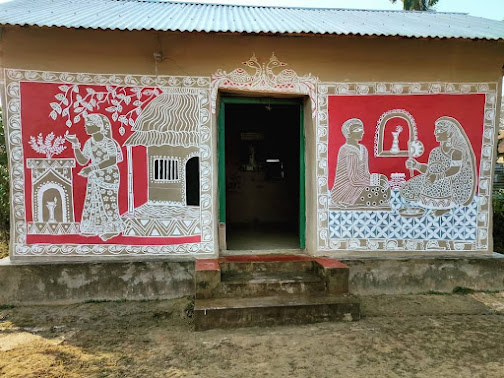Indian Calendar: A Cultural and Historical Perspective
By Dr. Asit Kumar Maity
Abstract
The Indian calendar is a complex lunisolar timekeeping system that has guided
Indian society for millennia. This article provides an overview of its
historical origins, regional adaptations, astronomical foundations, cultural
significance, and relevance in contemporary India. Drawing from ancient
scriptures, astronomical treatises, and modern academic sources, it highlights
the Indian calendar as both a scientific achievement and a cultural cornerstone.
Introduction
The Indian calendar is one of the oldest and most intricate
timekeeping systems in the world. It integrates both lunar and solar cycles,
serving to track time, organize festivals, and coordinate agricultural and
religious practices. The calendar’s origins can be traced back to the Rigveda,
which states: “The year is divided into twelve months, and each month is divided
into two fortnights” (Rigveda, 1.164.48). These early astronomical
observations laid the foundation for a highly advanced timekeeping system.
Historical Development
The Indian calendar originated during the Vedic period
(~1500 BCE). Initially based on lunar months, the system incorporated
intercalary months (adhik maas) to synchronize the lunar months with the solar
year. Over time, astronomers such as Aryabhata, Varahamihira, and
Brahmagupta developed more sophisticated models and calculations. “The
Vedic calendar was based on the lunar cycle, with an intercalary month added
every 2.7 years to keep it in sync with the solar year.” — Romila Thapar, Early Indian History (2004). Scientific and Astronomical Basis The Indian
calendar integrates both astronomy and astrology. Key elements include: Tithi: A lunar day, with 30 tithis per lunar month. Nakshatra: 27
lunar constellations the moon passes through each month. Rashi: The 12
zodiac signs the sun travels through annually. Samvatsara: A 60-year cycle
used in Hindu astrology. These elements are critical for determining auspicious
timings (muhurta), religious events, and agricultural activities.
Cultural
Significance
The Indian calendar is integral to cultural and religious life in
India. Major festivals such as Diwali, Holi, Navratri, Makar
Sankranti, and Pongal are tied to lunar phases or solar transits. The Bhagavad Gita reflects the significance of these cycles: “The cycles of time
are governed by the laws of nature, and all living beings are subject to these
cycles.” (*Bhagavad Gita*, 8.17)
Timeline of Key Milestones
Period Event/Contribution
c. 1500 BCE Calendar referenced in Rigveda (early Vedic calendar)
499 CE Aryabhata authors Aryabhatiya
505 CE Varahamihira writes Panchasiddhantika
628 CE Brahmagupta develops rules for lunar months and
zero
825 CE Start of Malayalam calendar (Kollavarsham)
1584 CE Bengali calendar (Bangabda) introduced under Akbar
1957 CE Shaka calendar
adopted officially by Government of India
Regional Variations
.png) |
| BENGALI CALENDAR |
The
Bengali Calendar (Bangabda) The Bengali calendar is used in West Bengal and
Bangladesh. It was formalized during Akbar's reign to align taxation with
harvest cycles. The calendar begins with Pohela Boishakh (April 14/15).
- Months: Boishakh, Joishtho, Asharh, Shraban, Bhadro, Ashwin, Kartik, Agrahayan, Poush, Magh, Falgun, Chaitra
- Reformed by Bangla Academy in Bangladesh (1966)
- The traditional version is still used for festivals and rituals in West Bengal
The Tamil Calendar
The Tamil calendar is a solar calendar
predominantly used in Tamil Nadu and by Tamil communities worldwide. It begins
with Chithirai (mid-April).
- Months: Chithirai, Vaikasi, Aani, Aadi, Avani, Purattasi, Aippasi, Karthigai, Margazhi, Thai, Maasi, Panguni
- Based on a 60-year cycle
- Key festivals: Pongal, Tamil New Year, Thaipusam
The Malayalam Calendar (Kollavarsham)
The Malayalam calendar is a solar
calendar used in Kerala, first introduced in 825 CE. It begins with Chingam (August-September).
- Months: Chingam, Kanni, Thulam, Vrischikam, Dhanu, Makaram, Kumbham, Meenam, Medam, Edavam, Mithunam, Karkidakam
- Official calendar of the Kerala government
- Used for scheduling Onam, Vishu, and other festivals
Regional Calendars by Region
- North India: Vikram Samvat (Uttar Pradesh, Rajasthan, etc.)
- West Bengal & Bangladesh: Bengali Calendar (Bangabda)
- Tamil Nadu: Tamil calendar
- Kerala: Malayalam calendar (Kollavarsham)
- Maharashtra/Karnataka: Shaka calendar
- Punjab: Nanakshahi calendar (used by Sikhs)
- Assam: Bhaskar Era calendar
Modern Use and Adaptations
Today, India uses the Shaka calendar (adopted in 1957) for official civil purposes, alongside the Gregorian
calendar. However, traditional regional calendars and astrological charts
remain crucial for religious and cultural life.
Key Contributors
- Aryabhata: Introduced mathematical constants and calendrical models in Aryabhatiya.
- Varahamihira: Compiled five astronomical systems in Panchasiddhantika.
- Brahmagupta: Developed rules for lunar cycles and introduced the concept of zero.
Conclusion
The Indian calendar is a unique
fusion of astronomy, tradition, and culture. Its lunisolar nature, regional
adaptations, and philosophical foundations continue to influence millions of
people in India and beyond. As both a scientific and cultural artifact, the
Indian calendar is a living tradition that remains deeply embedded in Indian
identity.
References
- Thapar, R. (2004). Early Indian History: Some Ideas and Perspectives. In B. Chattopadhyaya (Ed.), A Companion to Indian History(pp. 3–20). New Delhi: Munshiram Manoharlal.
- Rao, S. B. (2000). Indian Astronomy: An Introduction. Hyderabad: Universities Press.
- Davis, R. H. (2015). The Bhagavad Gita: A Biography. Princeton University Press.
- Rigveda. (c. 1500 BCE). Translated by R. T. H. Griffith.
- Bhagavad Gita. (c. 400 BCE). Translated by Eknath Easwaran.
- Pingree, D. (1978). History of Mathematical Astronomy in India. Harvard University Press.
- Sen, S. N. (1992). Ancient Indian Chronology. University of Calcutta.





Comments
Post a Comment